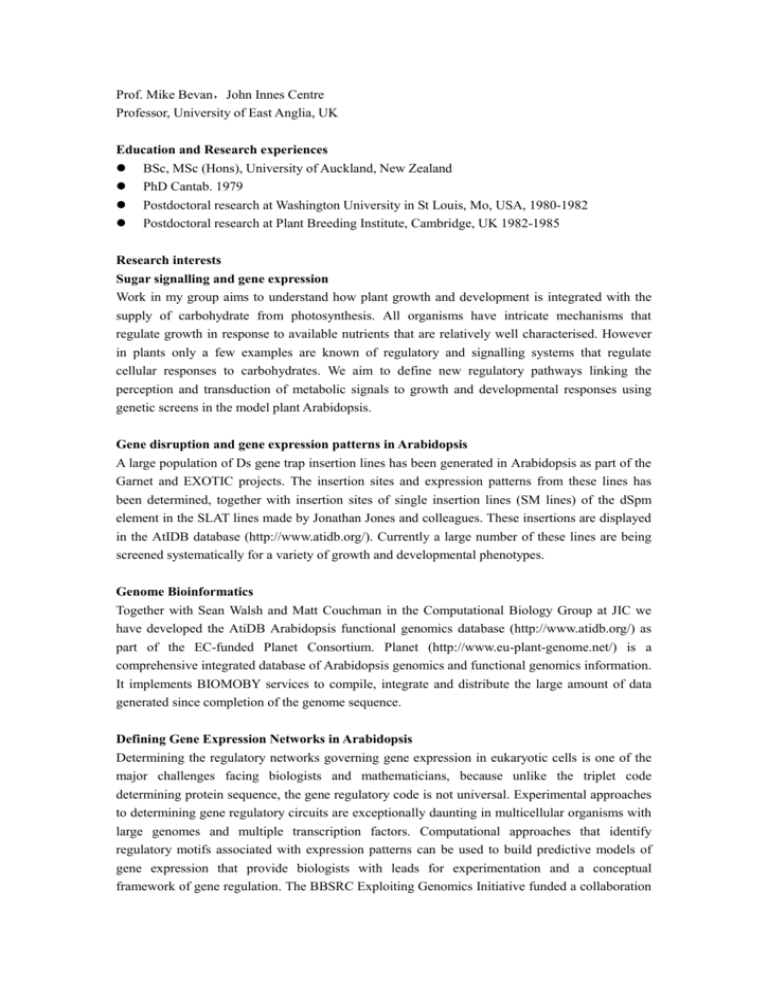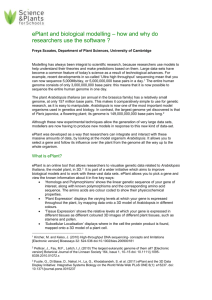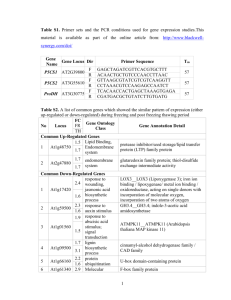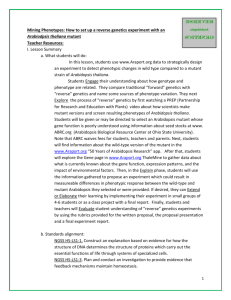Prof. Mike Bevan,John Innes Centre Professor, University of East
advertisement

Prof. Mike Bevan,John Innes Centre Professor, University of East Anglia, UK Education and Research experiences BSc, MSc (Hons), University of Auckland, New Zealand PhD Cantab. 1979 Postdoctoral research at Washington University in St Louis, Mo, USA, 1980-1982 Postdoctoral research at Plant Breeding Institute, Cambridge, UK 1982-1985 Research interests Sugar signalling and gene expression Work in my group aims to understand how plant growth and development is integrated with the supply of carbohydrate from photosynthesis. All organisms have intricate mechanisms that regulate growth in response to available nutrients that are relatively well characterised. However in plants only a few examples are known of regulatory and signalling systems that regulate cellular responses to carbohydrates. We aim to define new regulatory pathways linking the perception and transduction of metabolic signals to growth and developmental responses using genetic screens in the model plant Arabidopsis. Gene disruption and gene expression patterns in Arabidopsis A large population of Ds gene trap insertion lines has been generated in Arabidopsis as part of the Garnet and EXOTIC projects. The insertion sites and expression patterns from these lines has been determined, together with insertion sites of single insertion lines (SM lines) of the dSpm element in the SLAT lines made by Jonathan Jones and colleagues. These insertions are displayed in the AtIDB database (http://www.atidb.org/). Currently a large number of these lines are being screened systematically for a variety of growth and developmental phenotypes. Genome Bioinformatics Together with Sean Walsh and Matt Couchman in the Computational Biology Group at JIC we have developed the AtiDB Arabidopsis functional genomics database (http://www.atidb.org/) as part of the EC-funded Planet Consortium. Planet (http://www.eu-plant-genome.net/) is a comprehensive integrated database of Arabidopsis genomics and functional genomics information. It implements BIOMOBY services to compile, integrate and distribute the large amount of data generated since completion of the genome sequence. Defining Gene Expression Networks in Arabidopsis Determining the regulatory networks governing gene expression in eukaryotic cells is one of the major challenges facing biologists and mathematicians, because unlike the triplet code determining protein sequence, the gene regulatory code is not universal. Experimental approaches to determining gene regulatory circuits are exceptionally daunting in multicellular organisms with large genomes and multiple transcription factors. Computational approaches that identify regulatory motifs associated with expression patterns can be used to build predictive models of gene expression that provide biologists with leads for experimentation and a conceptual framework of gene regulation. The BBSRC Exploiting Genomics Initiative funded a collaboration with Gavin Cawley in the Computing Sciences Dept at the University of East Anglia to use machine learning methods to analyse Arabidopsis microarray data. We have developed a promoter classification method using a Relevance Vector Machine that identified discriminatory features in promoter sequences that correctly classified the expression patterns of over 70% of promoters according to known and novel promoter sequences. Recent Publications Garvin D. F., McKenzie N., Vogel J. P., Mockler T. C., Blankenheim Z. J., Wright J., Cheema J. J. S., Dicks J., Huo N., Hayden D. M., Gu Y., Tobias C., Chang J. H., Chu A., Trick M., Michael T. P., Bevan M. W., Snape J. W. (2010)An SSR-based genetic linkage map of the model grass Brachypodium distachyon. Genome 53 (1) 1-13 Thole V., Worland B., Wright J., Bevan M., Vain P. (2010) Distribution and characterization of more than 1000T-DNA tags in the genome of Brachypodium distachyon community standard line Bd21. Plant Biotechnology Journal 8 (6) 734-47 Wright J. M., Febrer M., McKenzie N., Byrne M. E., Walsh S., Higgins J., Bevan M. W. (2010) Genome sequencing and analysis of the model grass Brachypodium distachyon. Nature 463 (7282) 763-768 Alves S. C., Worland B., Thole V., Snape J. W., Bevan M., Vain P. (2009) A protocol for agrobacterium-mediated transformation of Brachypodium distachyon community standard line Bd21. Nature Protocols 4 (5) 638-649 Febrer M., Wilhelm E., Al-Kaff N., Wright J., Powell W., Bevan M. W., Boulton M. I. (2009) Rapid identification of the three homoeologues of the wheat dwarfing gene Rht using a novel PCR-based screen of three-dimensional BAC pools. Genome 52 (12) 993-1000 Thole V., Alves S. C., Worland B., Bevan M. W., Vain P. (2009) A protocol for efficiently retrieving and characterising flanking sequence tags (FSTs) in Brachypodium distachyon T-DNA insertional mutants. Nature Protocols 4 (5) 650-661 Baier M., Hemmann G., Holman R., Corke f., Card R., Smith C., Rook F., Bevan M. W. (2004) Characterization of mutants in Arabidopsis showing increased sugar-specific gene expression, growth, and developmental responses. Plant Physiology 134, 81-91. Bevan M. (2002) Genomics and plant cells: application of genomics strategies to Arabidopsis cell biology. Philosophical Transactions of the Royal Society, London B. 357, 731-736. Bevan M. (2002) Plant biology - The first harvest of crop genes. Nature 416, 590-591. Bevan M., Mayer K., White O., Eisen J. A., Preuss D., Bureau T., Salzberg S. L., Mewes H-W. (2001) Sequence and analysis of the Arabidopsis genome. Current Opinion in Plant Biology 4, 105-110. Conlan RS, Hammond-Kosack M, Bevan M (1999) Transcription activation mediated by the bZIP factor SPA on the endosperm box is modulated by ESBF-1 in vitro. Plant Journal 99 173-181 Cano-Delgado A., Penfield S., Smith C., Catley M., Bevan M. (2003) Reduced cellulose synthesis invokes lignification and defense responses in Arabidopsis thaliana. Plant Journal 34, 351-362. Copenhaver GP, Nickel K, Kuromori T, Benito MI, Kaul S, Lin XY, Bevan M, Murphy G, Harris B, Parnell LD, McCombie WR, Martienssen RA, Marra M, Preuss D (1999) Genetic definition and sequence analysis of Arabidopsis centromeres. Science 286 2468-2474 Li Y., Sorefan K., Hemmann G., Bevan M. W. (2004) Arabidopsis NAP and PIR regulate Actin-based cell morphogenesis and multiple developmental processes. Plant Physiology 136, 3616-3627. Mayer, K., et al (1999) Sequence and analysis of chromosome 4 of the plant Arabidopsis thaliana. Nature 402 769-777 Mayer K., Murphy G., Tarchini R., Wambutt R., Volckaert G., Pohl T., Dusterhoft A., Stiekema W., Entian K-D., Terryn N., Lemcke K., Haase D., Hall C. R., van Dodeweerd A-M., Tingey S. V., Mewes H. W., Bevan M. W., Bancroft I. (2001) Conservation of microstructure between a sequenced region of the genome of rice and multiple segments of the genome of Arabidopsis thaliana. Genome Research 11, 1167-1175. Meissner RC, Jin HL, Cominelli E, Denekamp M, Fuertes A, Greco R, Kranz HD, Penfield S, Petroni K, Urzainqui A, Martin C, PazAres J, Smeekens S, Tonelli C, Weisshaar B, Baumann E, Klimyuk V, Marillonnet S, Patel K, Speulman E, Tissier AF, Bouchez D, Jones JJD, Pereira A, Wisman E, Bevan M. (1999) Function search in a large transcription factor gene family in Arabidopsis: Assessing the potential of reverse genetics to identify insertional mutations in R2R3 MYB genes. Plant Cell 11 1827-1840 Pan X., Liu H., Clarke J., Jones J., Bevan M., Stein L. (2003) ATIDB: Arabidopsis thaliana insertion database. Nucleic Acids Research 31, 1245-1251. Patzlaff A., McInnis S., Courtenay A., Surman C., Newman L. J., Smith C., Bevan M. W., Mansfield S., Whetten R. W., Sederoff R. R., Campbell M. M. (2003) Characterisation of a pine MYB that regulates lignification. Plant Journal 36, 743-754. Patzlaff A., Newman L. J., Dubos C., Whetten R. W., Smith C., McInnis S., Bevan M. W., Sederoff R. R., Campbell M. M. (2003) Characterisation of PtMYB1, an R2R3-MYB from pine xylem. Plant Molecular Biology 53, 597-608. Penfield S., Meissner R. C., Shoue D. A., Carpita N. C., Bevan M. W. (2001) MYB61 is required for mucilage deposition and extrusion in the arabidopsis seed coat. Plant Cell 13, 2777-2791. Rook F., Bevan M. W. (2003) Genetic approaches to understanding sugar-response pathways. Journal of Experimental Botany 54, 495-501. Rook F., Corke F., Card R., Munz G., Smith C., Bevan M. W. (2001) Impaired sucrose-induction mutants reveal the modulation of sugar-induced starch biosynthetic gene expression by abscisic acid signalling. Plant Journal 26, 421-433. Schwechheimer, C., Corke, F., Smith, C. and Bevan, M. (2000). Transactivation of a target gene through feed-forward loop activation in plants. Functional and Integrative Genomics 1. 35-43 Tabata, S., Kaneko, T., Nakamura, Y. et al. (2000) Sequence and analysis of chromosome 5 of the plant Arabidopsis thaliana. Nature 408: 823-826. The Arabidopsis Genome Intiative (2000). Analysis of the genome sequence of the flowering plant Arabidopsis thaliana. Nature 408: 796-815. Wambutt, R., Murphy G., Volckaert, G., et al. (2000). Progress in Arabidopsis genome sequencing and functional genomics. J. Biotechnology 78: 281-292. Zourelidou M., de Torres-Zabala M., Smith C., Bevan M. W. (2002) Storekeeper defines a new class of plant-specific DNA-binding proteins and is a putative regulator of patatin expression. Plant Journal 30, 489-497.

![the registration form [DOC format, 30KB].](http://s3.studylib.net/store/data/007326701_2-7aa061ae2787fe2d09dcfa408150476a-300x300.png)








